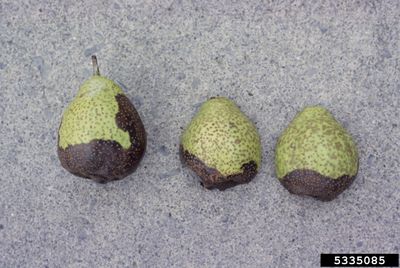What Causes Pear Black Rot?
Pears with black rot have been infected by a fungus called Physalospora obtusa (syn. Botryosphaeria obtusa). It overwinters in cankers on trees and in leaf matter, old fruit, and twigs on the ground. The prime conditions for infection are warm and wet weather in the spring. Trees are likely to become infected through sites where they have been wounded, mechanically, by insects, or by other diseases. The fruit can get infected through the calyx end, even if the overall tree is not infected.
Pear Black Rot Information – Symptoms
The characteristic sign of black rot on pears is a brown spot on the fruit that darkens and widens with age. When the rot sets in while the fruit is on the tree, you may see concentric brown rings as the rot develops. Some fruit may not show signs of rot until in storage. The rotten spot is firm and in advanced stages will develop dark pustules in the center. Signs of the disease on the tree usually begin with the leaves. They develop small, purple spots that develop into larger purple marks with brown centers. The leaves may eventually yellow and drop. On twigs look for sunken brown or red spots, and, on larger limbs and the trunk, these spots will form larger cankers.
How to Control Pear Black Rot
There are two main ways to control this disease in pears: use good sanitation and clean-up practices to prevent its spread, and if necessary, use a fungicide to treat trees. Remove and destroy leaf matter, affected twigs and limbs, and rotted fruit. Keep the ground under trees clear of debris and sanitize tools after working on an infected tree. Fungicides are effective in managing black rot of pear. Application is typically in spring but check with your local extension service to find out which fungicide is best and how and when to apply it to your pear trees.
